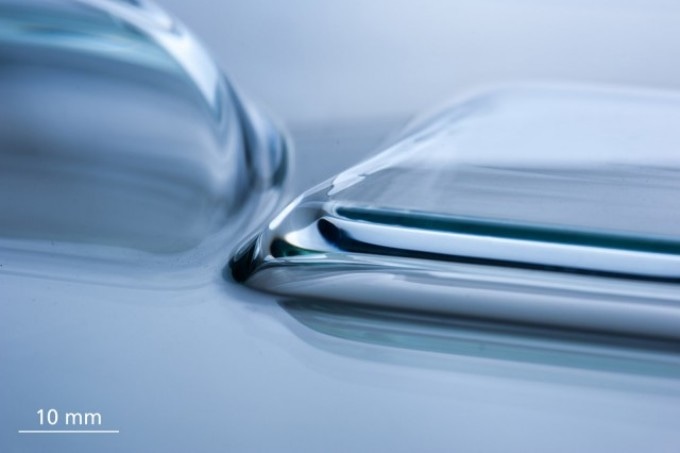May 3 2017
 Prototype sheet glass with very small radii, produced using the new laser-based glass forming technology (Credit: Photo Fraunhofer IWM)
Prototype sheet glass with very small radii, produced using the new laser-based glass forming technology (Credit: Photo Fraunhofer IWM)
Researchers at Fraunhofer Institute have developed a novel method that can be used to bend sheet glass into unconventional or complex shapes using laser beams. This breakthrough approach paves the way for a new range of promising products for designers and architects.
Glass has a specific attribute, i.e., they become viscous and malleable when subjected to high temperatures. The rest is done by gravity and precise calculations. The researchers are exploiting this attribute in their study.
A laser beam moves across the glass surface with excellent precision, tracing a preprogrammed if still imperceptible path. From time to time, the beam stops, alters position, and then moves on. A glass sheet measuring 4 mm thick is placed in an oven, which has been preheated to just below the temperature — the temperature at which point the glass starts to melt. Then, the glass begins to soften at the points that were heated by the laser and, due to gravity, the laser-heated portions begins to drop as if they were made of thick honey. After the preferred shape or form is obtained, the laser is turned off and the glass re-solidifies. The end result is a remarkable shape with bends having waves, small radii, and round protrusions.
This is one area of where lasers can be effectively applied to bend sheet glass in a process devised by the Fraunhofer Institute for Mechanics of Materials IWM in Freiburg im Breisgau. The entire process is based on a specific physical property of the material; for example, glass is different metal and lacks a definitive melting point at which it liquefies. Glass softens and becomes malleable when it is subjected to a certain temperature range
Bending glass without a mold
The laser-supported technique developed by Fraunhofer IWM enables both architects and industrial designers to utilize shapes that were difficult and costly to produce in the past. In the laser-supported technique, the sheet glass is shaped without using a bending mold to apply pressure. Thus, the novel process produces flat glass surfaces that remain visually undistorted and without leaving behind any ugly marks.
Laser beams controlled by software
Most importantly, programming the process workflow helps gives a product the desired shape. Geometrical data is employed to develop a program that will control the laser beam as well as define the sequence of precisely when, where, and for how long the material will be heated. This accounts for options to stop the laser for a short time, change the beam intensity, or heat a point multiple times. “Thanks to our technique, manufacturers have a cost-effective way of producing extremely customized glass objects in small batches or even as one-offs,” says Tobias Rist, scientist at Fraunhofer IWM.
Right from placing the glass in the preheated oven to cooling it off, the entire process takes just about 30 minutes. Based on the preferred shape, the laser takes only a few minutes to complete its job. “A distinct benefit for manufacturers is that the machine is only occupied for short times. The workpiece is placed in the preheated oven and lasering can begin after just a few minutes,” Rist explains. As the glass is taken off from the oven for cooling, the bending oven becomes free for the next workpiece and hence there is no need to cool it. This provides considerably more energy efficiency when compared to traditional processes – Although the laser needs plenty of energy, the short processing times save significant amounts of electricity.
Adjustable mirrors direct the laser beam
A powerful CO2 laser model is used by the Machining Processes, Glass Forming Group at Fraunhofer IWM. This specific laser is often employed in materials processing in the industry. Instead of directly applying on the workpiece, the laser beam is directed through adjustable mirrors that are fixed to the oven’s interior. This offers a simple yet rapid way to position the laser beam because the laser apparatus itself can continue to remain static. At present, the group’s researchers can process sheet glass with edges of up to 100 cm and change the shape of either side of the glass. The next step is to work with a wide range of glass and study more manufacturing differences with an aim to expand the variety of shapes products can take.